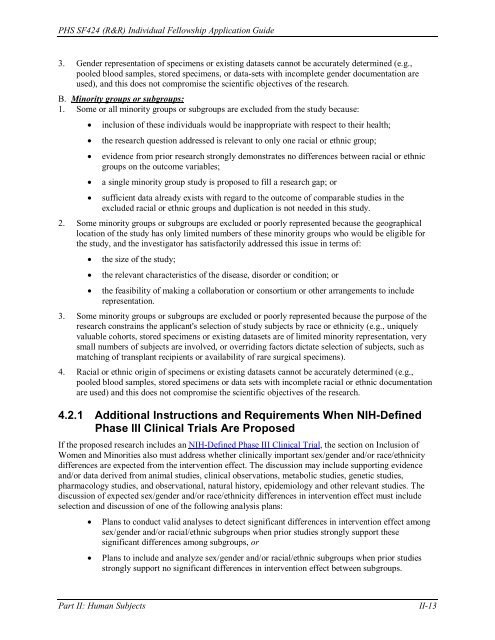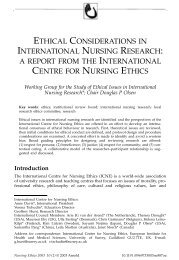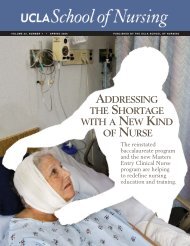Individual Fellowship Application Guide - UCLA School of Nursing
Individual Fellowship Application Guide - UCLA School of Nursing
Individual Fellowship Application Guide - UCLA School of Nursing
Create successful ePaper yourself
Turn your PDF publications into a flip-book with our unique Google optimized e-Paper software.
PHS SF424 (R&R) <strong>Individual</strong> <strong>Fellowship</strong> <strong>Application</strong> <strong>Guide</strong>3. Gender representation <strong>of</strong> specimens or existing datasets cannot be accurately determined (e.g.,pooled blood samples, stored specimens, or data-sets with incomplete gender documentation areused), and this does not compromise the scientific objectives <strong>of</strong> the research.B. Minority groups or subgroups:1. Some or all minority groups or subgroups are excluded from the study because:• inclusion <strong>of</strong> these individuals would be inappropriate with respect to their health;• the research question addressed is relevant to only one racial or ethnic group;• evidence from prior research strongly demonstrates no differences between racial or ethnicgroups on the outcome variables;• a single minority group study is proposed to fill a research gap; or• sufficient data already exists with regard to the outcome <strong>of</strong> comparable studies in theexcluded racial or ethnic groups and duplication is not needed in this study.2. Some minority groups or subgroups are excluded or poorly represented because the geographicallocation <strong>of</strong> the study has only limited numbers <strong>of</strong> these minority groups who would be eligible forthe study, and the investigator has satisfactorily addressed this issue in terms <strong>of</strong>:• the size <strong>of</strong> the study;• the relevant characteristics <strong>of</strong> the disease, disorder or condition; or• the feasibility <strong>of</strong> making a collaboration or consortium or other arrangements to includerepresentation.3. Some minority groups or subgroups are excluded or poorly represented because the purpose <strong>of</strong> theresearch constrains the applicant's selection <strong>of</strong> study subjects by race or ethnicity (e.g., uniquelyvaluable cohorts, stored specimens or existing datasets are <strong>of</strong> limited minority representation, verysmall numbers <strong>of</strong> subjects are involved, or overriding factors dictate selection <strong>of</strong> subjects, such asmatching <strong>of</strong> transplant recipients or availability <strong>of</strong> rare surgical specimens).4. Racial or ethnic origin <strong>of</strong> specimens or existing datasets cannot be accurately determined (e.g.,pooled blood samples, stored specimens or data sets with incomplete racial or ethnic documentationare used) and this does not compromise the scientific objectives <strong>of</strong> the research.4.2.1 Additional Instructions and Requirements When NIH-DefinedPhase III Clinical Trials Are ProposedIf the proposed research includes an NIH-Defined Phase III Clinical Trial, the section on Inclusion <strong>of</strong>Women and Minorities also must address whether clinically important sex/gender and/or race/ethnicitydifferences are expected from the intervention effect. The discussion may include supporting evidenceand/or data derived from animal studies, clinical observations, metabolic studies, genetic studies,pharmacology studies, and observational, natural history, epidemiology and other relevant studies. Thediscussion <strong>of</strong> expected sex/gender and/or race/ethnicity differences in intervention effect must includeselection and discussion <strong>of</strong> one <strong>of</strong> the following analysis plans:• Plans to conduct valid analyses to detect significant differences in intervention effect amongsex/gender and/or racial/ethnic subgroups when prior studies strongly support thesesignificant differences among subgroups, or• Plans to include and analyze sex/gender and/or racial/ethnic subgroups when prior studiesstrongly support no significant differences in intervention effect between subgroups.Part II: Human SubjectsII-13
















